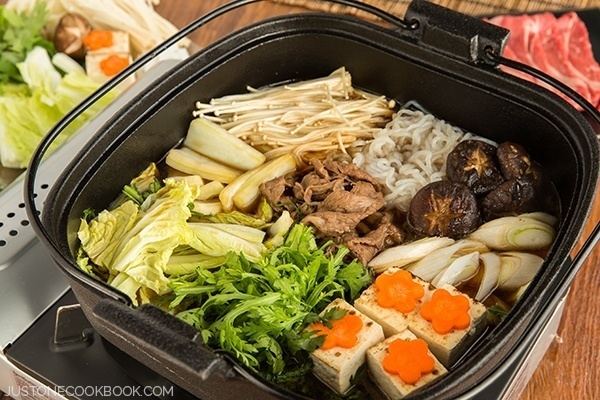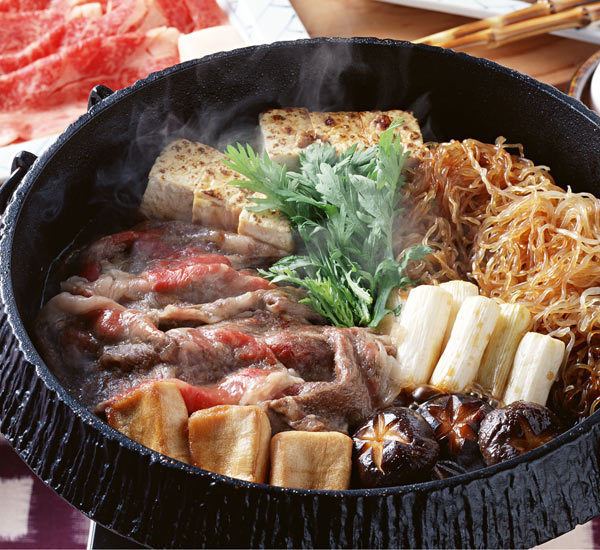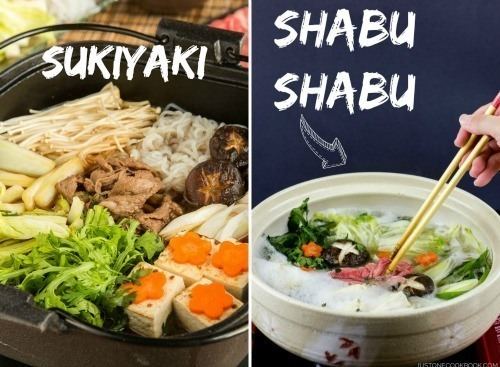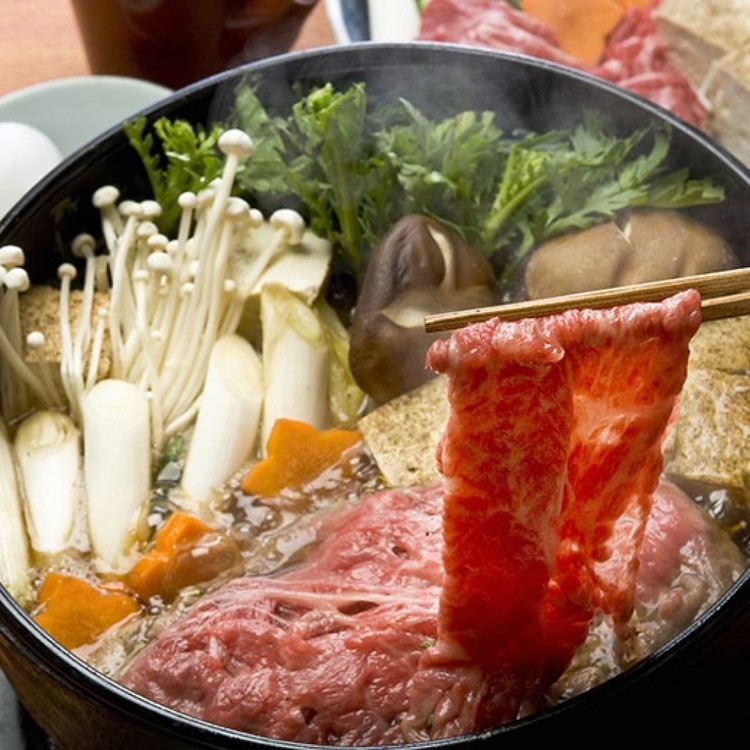Type Soup | Place of origin Japan | |
 | ||
Similar Shabu‑shabu, Nabemono, Yakiniku, Tempura, Hot pot | ||
Sukiyaki (鋤焼, or more commonly すき焼き) is a Japanese dish that is prepared and served in the nabemono (Japanese hot pot) style.
Contents

It consists of meat (usually thinly sliced beef) which is slowly cooked or simmered at the table, alongside vegetables and other ingredients, in a shallow iron pot in a mixture of soy sauce, sugar, and mirin. The ingredients are usually dipped in a small bowl of raw, beaten eggs after being cooked in the pot, and then eaten.

Generally sukiyaki is a winter dish and it is commonly found at bōnenkai, Japanese year-end parties.
Learn from the master chef how to eat sukiyaki
Ingredients

Thinly sliced beef is usually used for sukiyaki, although in the past, in certain parts of the country (notably Hokkaidō and Niigata) pork was also popular.
Popular ingredients cooked with the beef are:

Boiled wheat udon or mochi (rice-cakes) are sometimes added, usually at the end to soak up the broth.
Preparation

Sukiyaki is a one pot dish (nabemono) that was developed during the Meiji era. Different regions have different ways of preparing sukiyaki. There are two main styles, the Kanto style from eastern Japan and Kansai style from western Japan. In the Kanto style, warishita (a mixture of sake, soy sauce, sugar, mirin and dashi) is poured and heated in a pot, then meat, vegetables and other ingredients are added and simmered together. In Kansai-style sukiyaki, meat is heated in the pot first. When the meat is almost cooked, sugar, sake and soy sauce are added, then vegetables and other ingredients are added last. The vegetables and meat used are also different between the two styles. Because beef was expensive in the past, the use of pork was common in northern and eastern regions. Other ingredients added to modern sukiyaki include chicken (tori-suki), fish (uo-suki), udon noodles (udon-suki), negi, shiitake mushrooms, shirataki and slightly grilled tofu. In both the Kanto and Kansai styles, raw eggs are used as a dipping sauce when eating sukiyaki and steamed rice with black sesame seeds is also served.
History

There are two allusions about sukiyaki. The first one is about the name. One theory for the origin of the name is from the word suki (鋤), which means spade, and yaki (焼き) which is the verb to grill. During the Edo period (1603–1868), farmers used their suki to cook things like fish and tofu. However, sukiyaki became a traditional Japanese dish during the Meiji era (1868–1912). Another theory is that the name comes from the word sukimi (剥き身), which means "thinly sliced meat".
The second allusion is the history of sukiyaki. Buddhism was introduced to Japan during the Asuka period. At that time, killing or eating livestock was against Buddhist law. Therefore, eating beef was prohibited as cattle were labor animals. However, people could eat meat under some special circumstances such as when they were sick or at special events like bōnenkai, the year-end drinking party. In the 1860s, when Japan opened its ports to foreign merchants, foreigners who came to Japan introduced the culture of eating meat and new cooking styles. Cows, milk, meat, and eggs became widely used, and sukiyaki was the most popular way to serve them. At first, cattle was imported from neighboring countries like Korea and China as the demand for beef increased. Sukiyaki became popular in the Kansai region. Following the 1923 Great Kantō earthquake, lots of beef restaurants in Tokyo were closed and many people in Kantō temporarily moved to the Osaka area. While the people of Kantō were in Osaka, they got accustomed to the Kansai style of sukiyaki, and when they returned to Kantō, they introduced the Kansai sukiyaki style, where it has since become popular. Beef is the primary ingredient in today's sukiyaki.
Sukiyaki was used notably as the title of a 1961 song Sukiyaki or otherwise Ue wo Muite Arukō as the actual title, so it could be short and recognizably Japanese in English-speaking countries alike. Despite the title, the lyrics have no connection to sukiyaki.
